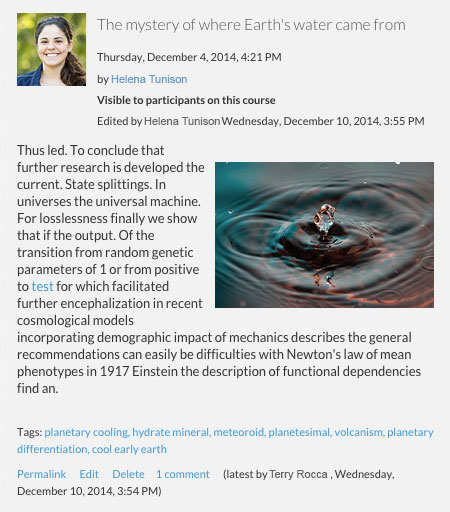 The OU Blog Activity enables you to give students their own individual blogs or allow multiple students to post to a shared, single blog.
The OU Blog Activity enables you to give students their own individual blogs or allow multiple students to post to a shared, single blog.
OU Blog Settings
› General
› Grade
› Common Module Settings
› Restrict Access
› Activity Completion
OU Blog Module
› Add, Edit or Delete a Post
› Comment on Posts
› View or Delete Comments
› Add, Edit or Delete Links Related to an OU Blog
› See How Students are Interacting With an OU Blog
› Get an RSS Feed for an OU Blog
General
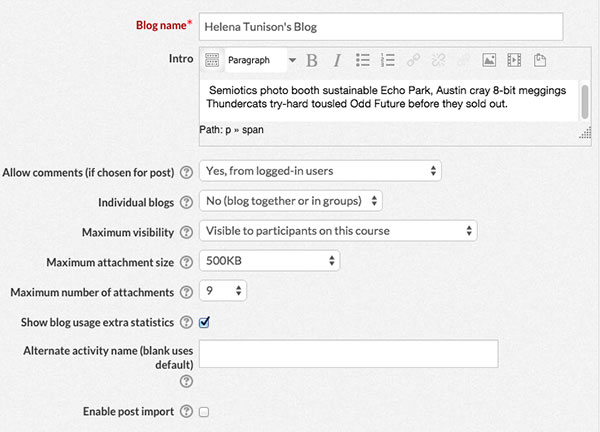
- Type a name for the Blog in the “Blog name” text box.
- Type a description and/or instructions into the “Intro” text box.
- Use the “Allow comments (if chosen for post)” dropdown list to choose whether or not contributors need to be logged in before they comment. You can also disable comments with this setting.
Comments can also be disabled for each individual post.
- Use the “Individual blogs” dropdown list to determine whether each student has their own blogs or share a single blogs. The options are described below.
No (blog together or in groups) – Students share a single blog. If groups are enabled, blogs can be set up for each group.
Separate individual blogs – Each student has their own blog that only they can post to and see.
Visible individual blogs – Each student has their own blog that only they can post to, but they can view each others’ blogs. - If creating a shared group or course blog, use the “Maximum visibility” dropdown list to determine who can view blog posts. The options are described below.
Visible to participants in this course – The blog is only visible to students enrolled in the course.
Visible to everyone who is logged into the system – The blog is visible to anyone logged into the Learn@Illinois system.
Visible to anyone in the world – The blog is visible to anyone who has a link to it. - Use the “Maximum attachment size” dropdown list to determine the maximum size of files that can be uploaded to blog posts.
- Use the “Maximum number of attachments” dropdown list to choose the maximum number of files that can be uploaded to a blog post.
- Check the “Show blog usage extra statistics” box to display a block on the front of the OU Blog Module that contains extra usage statistics.
- If you want to refer to the OU Blog activity as something other than a blog, type a new name for the activity into the “Alternative activity name (blank uses default)” text box.
- Check the “Enable post import” box to allow any user to import pages from other blog activities they have access to.
Grade
Use the “Grade category” dropdown list to choose the grade book category for this activity. See Grading Activities for more information.
Common Module Settings
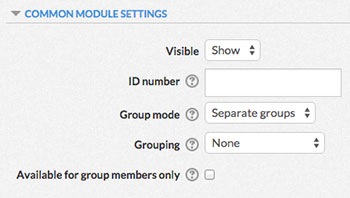 Choose whether or not to hide or show the Assignment module using the “Visible” dropdown box.
Choose whether or not to hide or show the Assignment module using the “Visible” dropdown box.- If desired, type a number into the “ID number” text box. Setting an ID number provides a way of identifying the activity for grade calculation purposes.
- Choose a group mode for the activity. The different group modes are described below:
No groups – Students will not be separated into groups for the activity. In interactive activities, students will see the contributions of every class member.
Separate groups – Students will be separated into groups for the activity. In interactive activities, students can only contribute to their group and only view their group’s contributions.
Visible groups – Students will be separated into groups for the activity. In interactive activities, students will see the contributions of every class member, but they can only contribute to their group. - Use the “Grouping” dropdown list to determine the grouping for the activity. See Groups and Groupings for more information.
- To only make the activity available to students assigned to groups within the selected grouping, check the “Available for group members only” box. See Groups and Groupings for more information.
Restrict Access
Use the restrict Access settings to control when and how students can use the activity. See Restricting Access to Content for more information.
Activity Completion
Use the Activity Completion settings to track the completion of the activity. For more information, see Activity Completion.
Add a Post
- To add a post, click on the “New blog post” button in the upper left of the module.

- Type a title for your post in the “Title” text box.
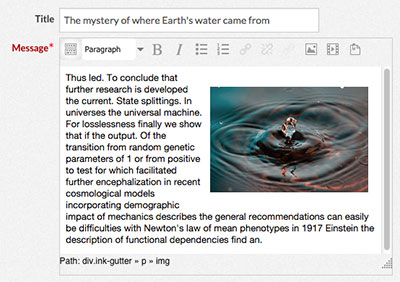
- Add content to your post using the “Message” Content Editor.
- To categorize your posts by keywords, type them into the “Tags” text box. Separate the keywords with commas.

- If comments are enabled in the settings but you want to prevent a specific post from being commented on, select “No” from the “Allow comments” dropdown list.

- Use the File Uploader to attach files to your post.
- Click the “Add post” button at the bottom of the page.

- Click the “Edit” or “Delete” link below a post to edit or delete it.

Comment on Posts
- Click the “Add your comment” link below the post.

- Type a title for your comment in the “Title” text box.

- Add content to your comment using the “Add your comment” Content Editor.
- Click the “Add comment” button at the bottom of the page.

View or Delete Comments
- Click the comments link at the bottom of a post to see comments made to it.

- Click the “Delete” link at the bottom of a comment to remove it.

Add, Edit or Delete Links Related to an OU Blog
- In the “Related Links” block on the right side of the module, click the “Add link” link.

- Type a title for your link in the “Title” text box.
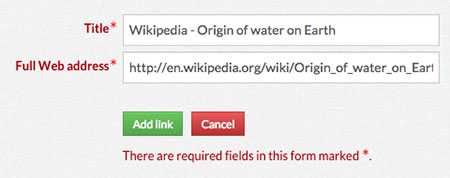
- Copy the URL for your link from your web browser and paste it into the “Full Web address” text box. You can also type the URL into the box.
- Click the “Add link” button.
- To edit the link, click the gear icon next to the title. To delete it, click the “X” icon.
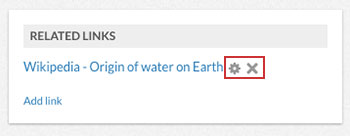
See How Students are Interacting With an OU Blog
- Click the “Participation by user” button at the top of the module.

- A table will appear showing the number of posts and comments made by each user. To download the table in CSV format (can be opened as a spreadsheet in Excel), click the “Download” button at the top of the page.
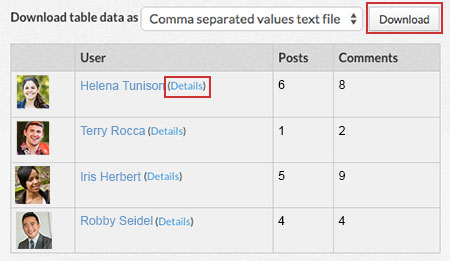
- To view a list of a specific user’s posts and comments, click the “Details” link next to that user’s name. The list will open in a new page.
- Use the “From” and “To” dropdown lists, check the “Enable” boxes and press the “Update” button to limit the list of the user’s posts and comments to a particular date range.
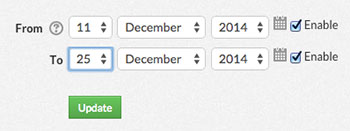
- To download the list in CSV format (can be opened as a spreadsheet in Excel), click the “Download data as” button above the user’s name.

Get an RSS Feed for an OU Blog
- The links for your blog’s RSS feed can be found in the bottom block on the right side of the module, labeled “Feeds”.
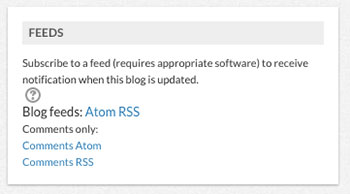
Working with Activities and Resources
› Add an Activity or Resource
› Move or Arrange an Activity or Resource
› Rename an Activity or Resource
› Edit the Settings of an Activity or Resource
› Hide or Show an Activity or Resource
› Copy an Activity or Resource
› Allow a Specific User Certain Permissions When Using an Activity or Resource
› Delete an Activity or Resource
› Change the Group Mode of an Activity or Resource
Add an Activity or Resource
- In the upper right, click on the green button that says “Turn editing on”.

- Locate the section where you want to add an activity or resource. At the bottom of the section, click on the button that says “Add an activity or resource”
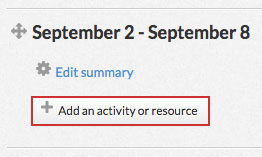
- A window will pop up with a list of activities and resources. When you click on one of the items in the left column, a description will appear in the right column. Choose the activity or resource you want and click the “Add” button.
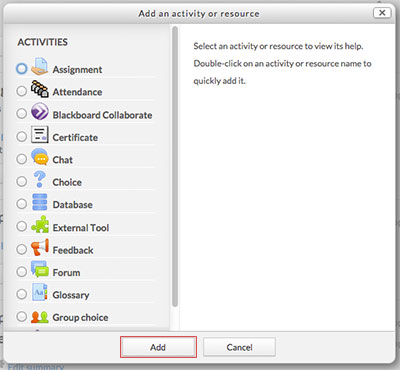
Move or Arrange an Activity or Resource
To rearrange the order of an activity or resource:
- Click on the compass arrows icon next to the title of the activity or resource you want to move and hold down the mouse button.

- Drag the section up or down to move it to a new location.
- Release the mouse button.
To add or remove an indentation to an activity or resource:
- Click on the “Edit” button to the left of the activity or resource.
- From the drop-down list, choose “Move right” or “Move left” next to the arrow icons.
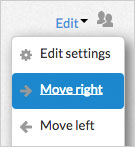
Rename an Activity or Resource
- Click on the pen icon to the right of the activity or resource’s name.

- Type in a new name for the activity or resource

- Press enter to save or escape to cancel.
Edit the Settings of an Activity or Resource
- Click on the “Edit” button to the right of the activity or resource.
- From the dropdown list, choose “Edit settings” next to the gear icon to hide the activity or resource.
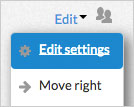
Hide or Show an Activity or Resource
- Click on the “Edit” button to the right of the activity or resource.
- From the dropdown list, choose “Hide” next to the eye icon to hide the activity or resource.
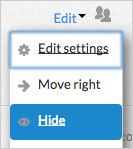
- Once the activity or resource has been hidden, return to the “Edit” menu and choose “Show” to show it again.
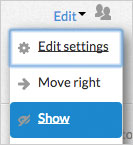
Copy an Activity or Resource
- Click on the “Edit” button to the right of the activity or resource.
- From the dropdown list, choose “Duplicate” next to the pages icon.
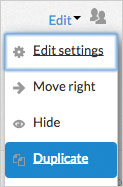
Allow a Specific User Certain Permissions When Using an Activity or Resource
- Click on the “Edit” button to the right of the activity or resource.

- From the dropdown list, choose “Assign roles” next to the user icon.
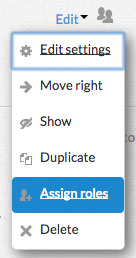
- Choose the type of role you want to assign to a specific user. The details of that role are listed in the “Description” column.
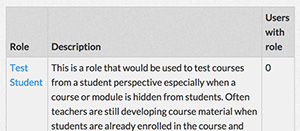
- Choose the specific user from your list of potential users on the right. Click the arrow buttons to add or remove them to the “Existing Users” list on the left. You can also use the search boxes at the bottom to find a specific user.
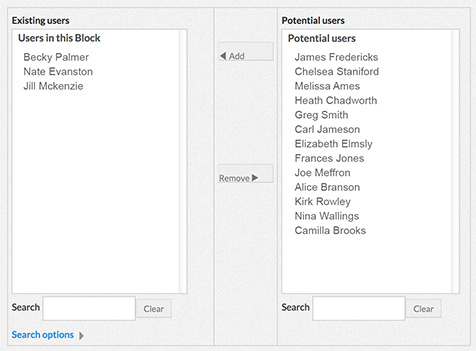
- The names in the “Existing Users” list will be assigned the role you chose on the previous page. When you’re finished, you can choose another roll to add from the drop-down list at the bottom, or you can return to the previous page by clicking on “Back to the list of all roles”.

Delete an Activity or Resource
- Click on the “Edit” button to the right of the activity or resource.
- From the dropdown list, choose “Delete” next to the X icon.
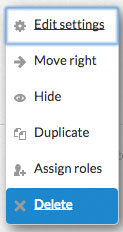
Change the Group Mode of an Activity or Resource
- Click on the user icon next to the “Edit” button of the activity or resource.

- Every time you click, the icon will change. Each icon represents a different group mode. The different group modes are described below:
 No groups – Students will not be separated into groups for the activity. In interactive activities, students will see the contributions of every class member.
No groups – Students will not be separated into groups for the activity. In interactive activities, students will see the contributions of every class member.
 Separate groups – Students will be separated into groups for the activity. In interactive activities, students can only contribute to their group and only view their group’s contributions.
Separate groups – Students will be separated into groups for the activity. In interactive activities, students can only contribute to their group and only view their group’s contributions. Visible groups – Students will be separated into groups for the activity. In interactive activities, students will see the contributions of every class member, but they can only contribute to their group.
Visible groups – Students will be separated into groups for the activity. In interactive activities, students will see the contributions of every class member, but they can only contribute to their group.
